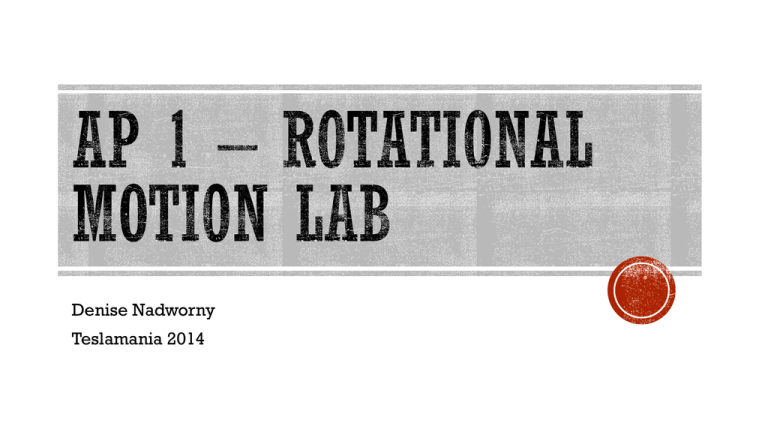File - Mrs. Nadworny's Website
advertisement

Denise Nadworny Teslamania 2014 Based on AP C Free Response Question Adapted from Kim Geddes’ AP C Rotational Motion Lab (http://geddesphysics.weebly.com/) A falling mass causes a pulley to rotate. The rotational acceleration can be determined using the acceleration of the falling mass. This can be used to determine the moment of inertia of the pulley. Place a ring stand on the edge of the table. Attach a long pole (ex – spare ring stand pole) to the ring stand. Hang a pulley from the farthest end of the pole. Tie a string around the pulley and a 50 g mass. Tape an index card to the mass. (Thin cardboard from back of a note pad worked best) Place a motion detector on the floor beneath the hanging mass. See setup video on website Students need to measure mass of mass with index card and radius of pulley. Set up the CBL calculator to collect distance and time data Data Collection – Time Graph Time Frame = 0.02 s Number of samples = 45 Wind up the pulley. Press enter to collect data. Wait for the clicks before releasing the pulley. Confirm the graph looks alright before importing to LoggerPro See setup video on website Connect the CBL unit to the computer Import data into LoggerPRo Raw Data Delete extraneous data Add point protectors, column labels, title Analyze with quadratic fit Note – This is from a different trial than the ‘raw data’ example graph Create a straightened graph by squaring time data Analyze with a linear fit Slope = (0.5)acceleration Which quantities should be graphed in order to best determine the acceleration of the block? Explain your reasoning. Distance versus Time Squared Slope = ½ acceleration d v i t 12 at 2 y mx Plot the quantities determined in (1), following all graphing rules. Determine the acceleration of the block. Slope = ½ acceleration a = 2(slope) Derive an expression for the tension in the string. Calculate this value. F ma Ft F g ma Ft mg ma Students need to plug in the acceleration as negative because it was falling, g is positive because the negative was already included in Ft - Fg Derive an expression for the angular acceleration of the pulley. a r a r Derive an expression for the moment of inertia of the pulley using the torque of a rotating body. I I Ft r Ft r Ft r 2 I a Ft r Use the expression determine in step 6 to calculate the moment of inertia for the pulley. Calculate the moment of inertia of the pulley using the solid disk formula. I 12 MR 2 Compare your two results with a percent difference. Explain why the differences in the two values likely occurred. Friction in the pulley – it does not rotate freely Assume constant radius (and that radius of pulley is radius of string) The radius decreases as the string unwinds The radius of pulley was measured from far edges – string stays inside “Blips” in the motion detector – individual needs to remove extraneous data points and may have removed too many or too few. Teslamania Tab: Student copy of lab Motion detector and LoggerPro instruction sheet This powerpoint Disclaimer – I make no guarantee that this is actually what AP 1 wants for rotational motion.







